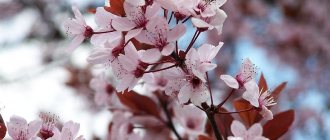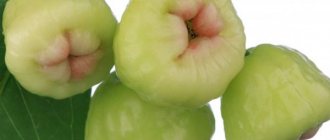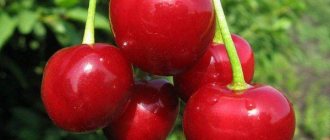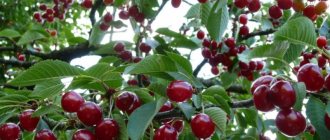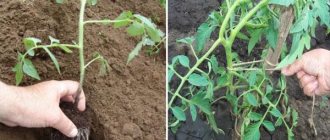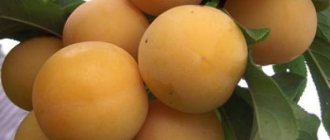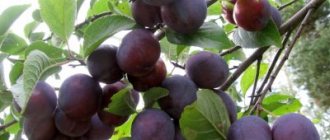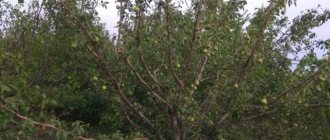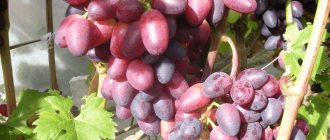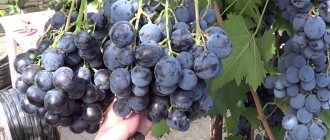History of selection
The plum variety Ksenia was bred in Russia, in the Altai region. In early 1967, breeders were able to obtain this variety as a result of natural pollination of the Red Ball species.
In 1970, this species was included in the State Register of the Russian Federation. Ideal for growing in the Central and Southern regions of the country.
Description of the tree
This variety belongs to early cultures. The harvest can be harvested at the end of July. The Ksenia plum tree is small. Its crown is sparse and resembles a broom. The shoots are characterized by high density and arched shape. Their color is brown with shades of gray.
The flowers on the tree are white. They create many inflorescences that can be seen in early May. By this moment, the leaves do not have time to fully form, which makes the bush specific in appearance.
Flowers are characterized by excellent resistance to frost (can survive temperatures down to -3°C). Resistance to drought and fungal diseases is noted. Fruiting is observed 3 years after planting the seedlings in a permanent place.
Fruit characteristics
The plum variety Ksenia is characterized by large round fruits. Their average weight is 40–60 g. Several other main characteristics are noted:
- the color of the fruit is yellow, there may be a red blush on the surface, occupying about 30% of the total area;
- medium funnel for petioles;
- the seam on the belly is shallow;
- the pulp is juicy, crispy, its color is close to golden;
- the taste is pleasant, without bitterness, notes of peach are noted;
- the aroma is reminiscent of peach.
The aroma of plum fruits of the Ksenia variety resembles the smell of peach
The plum variety Ksenia is a universal crop. Using it, you can prepare excellent compotes, jams and preserves. It is often used for making desserts and baby food. The fruits can also be eaten fresh.
Features of cultivation
When planting Ksenia plum, you should take into account that the plant may die if its root system is close to groundwater. For this reason, seedlings should be planted in elevated areas (hill or ridges). Hills must be made even if the snow level exceeds a height of 60 cm. Please note that the acid-base balance of the soil should be no more than 5%.
Creating ridges is not difficult. To do this, you need to take humus and lay it out up to 80 cm high. The width of such an area should be at least 2 m. You can add phosphate and potassium fertilizers to the humus, which will saturate the soil with useful microelements. For each bucket of humus there should be 500 g of such preparations.
When choosing a seedling, preference should be given only to two-year-old plants. They are more tolerant of frost and sudden changes in soil. The seedling must be placed in a hole 50 cm wide and 70 cm deep. The root collar should rise 10 cm above the ground. The roots should be carefully distributed throughout the hole, covered with earth and compacted. After this, small trenches are created around the tree, which will serve as protection against pests. Water can be poured into such trenches for irrigation. When planting, you should also take into account the scheme:
- there should be a distance of 60 cm between plants;
- between rows - about 80 cm.
Planting and care
According to cultivation statistics, plum ranks 3rd, second only to apple and pear. New plum varieties are developed every year. One of the best representatives of the culture is the Ksenia plum.
Plum Ksenia is one of the best representatives of culture
Description of the tree
Like any other fruit tree, the Ksenia plum has its own characteristics that should be taken into account when planting it in the ground.
Read more: Rabbits of the White Giant breed: description, maintenance and breeding
Recommended timing
The timing of planting the Chemal large plum depends on the specific area. In the middle and southern regions of Russia, the Ksenia plum can be planted after the snow melts. If the crop is intended for planting in the Urals or Siberia, then approximately 4 decades should be counted until the first frost, otherwise the plum seedling will not have time to establish itself in the ground.
An important role when planting Ksenia plums is played by the correctly chosen place. Elevated and well-lit areas are considered good locations. A suitable earthen substrate should be light or medium. Sand is added to heavy soil. The substrate should have a pH of 4.5–5.5.
The plum variety Ksenia suffers from too wet soil, so it should be planted in an area where groundwater does not lie too close to the surface. If the planting area is flat, it is necessary to build a ridge. It will raise the tree in winter, when the snow cover reaches 80 cm.
The Chemal large variety needs neighbors. Next to this tree it is worth planting other plums, an apple tree, and a black currant bush. If you plant thyme under the Ksenia plum, it will prevent the growth of weeds, and black elderberry will protect the Chemal variety from aphids.
It is not recommended to plant large poplar, birch, fir, walnut trees, and sea buckthorn near Chemalskaya.
In order for the tree to grow strong and healthy, it is necessary to choose the right material for planting. The plum seedling must be at least two years old, otherwise it will be difficult to transplant. A two-year large plant is more frost-resistant, and it can also withstand sudden changes in soil.
Landing algorithm
The Chemal large seedling has a closed root, so this planting material can be planted throughout the entire season. Recommended bed dimensions: height within 50 cm, width – 2 m. The length of the bed depends on the number of seedlings. A distance of 60 cm should be maintained between plum seedlings, and approximately 80 cm between rows.
- The roots of the plum are carefully distributed in the hole (the depth of which is 70 cm), then covered with soil.
- When a young plum seedling is planted in the ground, the soil should be trampled down to eliminate air gaps.
- The root collar is left above the ground (approximately 10 cm).
- At the base of the bed there is usually humus (about a bucket), mixed with superphosphate (2 handfuls), potassium salt (a handful) and wood ash (a shovel).
- It is necessary to build a small trench of earth around the planting hole, which will prevent water from spreading during irrigation, and also protect the Chemalskaya plum seedling from pests.
- After abundant watering, the young plant must be tied to a peg.
When planting, a large Chemal seedling should go into the ground by one third or half.
Fertilizers are applied when planting plums. Preference is given to organic components. 2 kg of compost are diluted in 10 liters of water. Pour 3 liters of the mixture under each tree. Phosphate and potassium fertilizers added to the soil will saturate it with useful substances. Ratio: 500 g of any drug per bucket of humus.
Fertilizers applied during planting will last for 3 years. You should not overfeed plums, as this will lead to excessive branching and reduced yield.
The large Chemal tree needs high humidity or regular watering. However, if you water the tree frequently, it will rot. Watering is carried out once a week, in the morning. In summer, the Ksenia plum should be moistened once every 30 days.
A young tree needs formative pruning. During fruiting - rejuvenating. Sanitary pruning is carried out every year, in the first ten days of March. Its goal is to remove dry branches that absorb many useful microelements from the ground.
After the Chinese plum Ksenia begins to bear fruit, it needs to be fed. The usual mixture consists of 7 kg of organic substance and 100 g of ash. After 2 or 3 years, fluff lime is added to the soil.
In the fall, the Chemal large one should be prepared for winter.
To do this you need:
- Remove dry and diseased branches, as well as excess branches.
- Add fertilizer.
- Dig up the soil (digging is carried out a year after planting the seedling).
- Clean the trunk from scales and whiten it.
To protect against rodents, you can use a simple and safe method: treat the crop with a mixture of clay and cow manure (1:1 ratio).
It is necessary to cover Ksenia for the winter in the following cases:
- if the tree is young;
- if the crop is planted in a harsh region.
For this, bags, paper, polyethylene, humus and other available materials can be used.
Gum treatment. Heavily fertilized plums, as well as crops exposed to severe frosts, can be affected by gum disease. Diseased areas of the tree should be cleaned with a knife and lubricated with copper sulfate.
Dwarfism. If the Chemal large tree’s development slows down, it is uprooted. To prevent dwarfism, you need to treat the plant with a clean tool.
Rust and clasterosporiasis. When rust occurs, small spots appear on the leaves. And with klyasterosporiosis, holes remain at the site of the spots that have arisen.
These diseases are fought with the help of Bordeaux mixture. It is also necessary to dig up the soil around the tree and cut and then burn old shoots.
Chlorosis appears in the veins. Ready-made products “Chelate” and “Antichlorosin” cope with the disease.
To combat the codling moth, painful areas are treated with Bordeaux mixture (2 mg per 10 liters of water).
To get rid of aphids, the drug “Oxychom” is used, which contains copper. The tree is sprayed with it (30 mg per 10 liters of water).
Read more: After which you can plant garlic before the winter of the predecessor crop
To protect the plum from other parasites, as well as to prevent diseases, the crop should be bleached with a limestone composition in which iron sulfate, mullein and clay are diluted. Whitewashing is carried out annually, in the first half of April.
When choosing a seedling, you should inspect it for damage to the trunk and roots; the tree should be no older than 2 years, otherwise it may simply not take root.
The Ksenia variety is a crop accustomed to cold frosts and the harsh northern climate. It does not tolerate excess moisture and may simply die. Before planting, you need to make sure that groundwater will not destroy it. It is best to do this on elevations and hills, in a well-lit area. You can make a ridge.
The greater the number of young trees, the longer the ridge should be:
- the distance between seedlings must be at least 1.5 m;
- compost, a handful of superphosphate and a handful of potassium salt should be added to the planting hole;
- the pit should be no more than 1.5 m deep;
- After planting, the tree needs to be well watered.
For 4 years after planting it does not require feeding. It is not recommended to water it often, so as not to destroy it, once a month is enough, but if autumn is without frequent rains, the plum may begin to dry out, so you need to monitor its condition and not leave it without sufficient moisture.
The plum will bear its first harvest 2-3 years after planting, after which it will bear fruit abundantly for 10-12 years. Before flowering begins, trees need to be pruned and given the correct shape. If necessary, a stake is installed next to the tree, to which the plum is tied. Try to plant it together with other trees that bloom at the same time so that they pollinate the plant.
Reproduction
Plum propagates by seeds or seeds. Prepare a special bed and plant the seeds; they may not sprout next winter, so wait a year before destroying the bed.
Agricultural technology
The Ksenia plum variety needs proper care.
- Watering. If you water the tree abundantly, it will begin to rot and soon die, so watering is carried out only in the morning using warm water. It is important to follow the watering interval, which is 1 week. You need to water the crop in such a way that about 20 liters of water gets under each bush.
- Fertilizers should be applied only during the planting period of the seedling. For this, organic components are used. You can dilute 2 kg of humus or compost in 10 liters of water and water each tree with 3 liters of the solution. After 3 years, when the effect of the fertilizer ends, similar solutions can be applied again.
- Pruning is carried out only until the plant begins to bloom. If you carry out the process of crown formation at the time of flowering, you can forget about high yields. At the beginning of March, you need to trim off damaged and dry areas that absorb too many nutrients from the soil.
The Ksenia plum variety is not self-fertile, so it is important to plant it near pollinators, otherwise the harvest will be minimal. When choosing pollinators, give preference to those varieties that bloom and ripen at the same time as her.
Plum Ksenia
Plum on a semi-dwarf rootstock. Seedlings by mail.
Landing dates.
The best time to plant plums is late April-early May. Autumn planting in most of Russia is associated with the risk of seedlings freezing in winter. However, seedlings with a closed root system take root well in the fall (but they must be planted no later than September 15-20).
Landing place.
Plum plants do not tolerate waterlogged soil. Due to the proximity of groundwater, the roots lack oxygen. This leads to weakened growth, non-ripening of annual shoots, and freezing of trees in winter. The depth of groundwater should be at least 1.5-2 m from the surface of the earth.
Plum grows well in almost all types of soil: sod-podzolic, gray forest, chernozem. However, obtaining abundant harvests is possible only on fertile and well-supplied soils. The best conditions for plum growth are on neutral and slightly alkaline soils with a pH of 7.0-7.5. In most of the country, acidic soils (pH less than 5.5) predominate, so before planting, it is necessary to deoxidize them with dolomite flour or chalk (at the rate of 2 kg per 1 sq.m.).
Preparing for landing.
Planting holes are prepared in advance: for autumn planting, 4-6 weeks; in spring - from autumn (in October) or spring (as soon as the soil thaws). When there are a lot of seedlings, they are placed in rows with a distance between plants in a row from 2.5-3 (for low-growing varieties) to 3-4 m (for vigorous-growing ones) and with row spacing of 4-5 m.
Planting holes are dug with a diameter of 60-80 cm and a depth of 50-60 cm. When digging a hole, the soil from the upper fertile layer is folded in one direction, and from the lower infertile layer in the other. Then the planting soil is prepared, which is made up in equal proportions of the top fertile layer, compost (or rotted manure) and river sand. 6 matchboxes of double superphosphate, 4 boxes of potassium sulfate and a liter jar of wood ash are added to it. Mix the soil well and fill the hole 2/3 with it.
Landing.
Planting stakes are driven into the center of the holes, which should be straight, cleared of bark, 150-160 cm long. The nutrient mixture in the hole before planting must be loosened and added to the stake in the form of a mound. It is more convenient to plant with two people: one places the seedling on the north side of the stake, straightens the roots, and the other covers them with fertile soil. To better fill the spaces between the roots with soil, the seedling is slightly shaken when filling, and the soil is carefully trampled down. After planting, the root collar should be 3-5 cm above the soil surface. After planting is completed, an earthen roller is poured along the border of the tree trunk circle. Then the young tree is well watered (2 buckets of water for one plant). Improving the survival rate and further growth of the seedling is facilitated by mulching the tree trunk circle with peat chips, humus, rotted manure or sawdust within a radius of 0.5 m in a layer of 8-10 cm.
The seedling is tied to the planting stake in two places, using twine or braid (the garter is done in a figure eight).
Trimming.
Planted seedlings must be pruned before buds begin to bloom. Annuals that do not have a crown are cut at a height of 70-80 cm from the soil surface. If the tree formation system has not yet been selected, the branches of a two-year-old seedling in the middle part of the crown are cut to 1/3 of the length, the lower ones - less, the higher ones - more. After pruning, all branches should be at the same level, and the central conductor should be 20 cm higher than them.
In subsequent years, the crown is formed. First of all, remove all branches located at an angle of less than 35 degrees to the trunk, as well as those growing inside the crown. In addition, crossing and weak branches are cut out. If desired, the height of the tree can be adjusted by cutting off the central conductor or transferring it to a strong side branch.
For plums, the most convenient is a sparse-tiered formation, when a conductor and three skeletal branches are left in the first tier at a distance of 20-25 cm from each other. In the second tier, four branches are left 50-60 cm lower.
Fertilizers.
Organic fertilizers are applied to a fruit-bearing tree in early spring or late autumn (per 1 sq.m. of trunk circle): 10 kg of rotted manure or compost. Mineral nitrogen-containing complex fertilizers, which enhance growth and foliage, are applied in the spring before flowering at the rate of 30 g per 1 sq. m. m of tree trunk circle. Two more feedings with mineral complexes containing nitrogen are carried out after the end of flowering and after the massive fall of the ovaries. In autumn, plums really need phosphorus and potassium.
Pests and diseases
This variety is disease resistant, so it can be affected by certain parasites. Among them, it is important to highlight the codling moth, aphids and ants. It is not difficult to combat such pests.
To get rid of the codling moth, you should spray the area with Bordeaux mixture (2 mg per 10 liters of water).
It is necessary to fight against aphids using the copper-containing preparation Oxychom for spraying (30 mg per 10 liters of water). Removal of beetles is carried out by bleaching the trunk with a limestone solution. To do this, mix lime with water in a ratio of 1:5. Whitewashing of the trunk is carried out annually, in early April.
Diseases and pests
The Chinese plum “Ksenia” is quite resistant to diseases, and this is very pleasing, because our local pests do not disdain the relocation, and perhaps they do not even notice the difference.
Measures to combat them have long been developed and are quite effective: insecticides before and after flowering, collecting and burning fallen leaves, whitewashing trunks with lime mortar with the addition of clay, mullein and iron sulfate
By diversifying the varietal composition of plum plantings, you will enrich the fruit table.
Not everyone likes the subcutaneous sourness of plums, and the Ksenia plum has it completely absent, not even the bitterness that is found in the Chinese plum.
The absolutely pure, unreal taste is what sets it apart from most other varieties often found in gardens, and for many this advantage will seem very important.
Description of the plum variety Ksenia
The fruit is round in shape and weighs approximately 40 g. Its color is yellow, with a crimson blush. The taste is juicy and sweet. The skin lacks the sourness inherent in many varieties of plums. The large variety Ksenia does not taste bitter like an ordinary Chinese plum. The ripe fruit falls off easily. According to the description of the Ksenia large plum variety, it differs from other crops in its large size, as well as the average depth of the abdominal seam. The yellow color of the fibrous pulp has a green tint. Subcutaneous points are barely noticeable. The seed of the Ksenia variety is freely separated from the pulp.
Plum propagation
The Chinese plum reproduces well from seeds, but do not forget about stratification, or better yet, sow it in a special bed before winter. If no seedlings appear next spring, do not destroy the bed, wait until next spring, and then draw conclusions.
The second method provides complete varietal purity, as it is vegetative.
When planting, the root collar is deepened and shoots grow from the scion. Deepening can be done later, the main thing is to be careful, the growth from the roots will give an analogue of the rootstock.
Characteristics of the variety
Among fruit trees, the large variety Ksenia occupies one of the leading places because it has excellent characteristics.
Drought resistance, frost resistance
The Kseenia plum is characterized by medium drought resistance. However, it tolerates winter well, holding the record for frost resistance. Various sources claim that the plum can withstand temperatures from 30 to 50 degrees below zero. Plum flowers can tolerate frost if they do not exceed 3 °C. However, the Ksenia plum is not resistant to diaper rash.
Plum pollinators
The Ksenia variety is self-sterile. Therefore, when planting large Chemal, it is worth considering that other plums are needed for its normal fruiting.
Productivity and fruiting
The Ksenia plum has a high yield, but its fruiting is irregular. Chemal large begins to produce crops 3–4 years after planting. Then it consistently bears fruit for ten years, and with proper care, this period is extended.
In terms of ripening, the Chemal variety is early. It bears fruit in late July - early August.
Area of application of berries
Plum Ksenia is considered a universal variety for the use of berries. They can be eaten fresh or used for culinary purposes. Compotes, juices, jams, desserts, and wine are prepared from large Chemal plums.
Resistance to diseases and pests
Chemal large plum has average resistance to various infectious and fungal diseases. But if the tree gets sick, you should take simple steps to cure it. For example, introduce insecticides, burn fallen plum leaves, whiten the trunk.
Advantages of the variety
Chemal large plum is a favorite tree of many gardeners. It has excellent product characteristics and good transportability; appetizing appearance; extraordinary taste without bitterness or sourness.
This distinguishes the Ksenia plum from other species.
Features of growing plum Ksenia
A tasty and juicy fruit that grows in almost every self-respecting gardener is the plum. They not only bring a rich harvest, but also bloom beautifully in the spring. The Ksenia plum variety is not only beautiful, it differs from all plums in that it has very large and juicy fruits.
Features of the variety
Plum Ksenia is one of the earliest varieties and begins to bloom at the end of April. It blooms for about 2 weeks, the flowers are quite large. The tree is of medium height, has a sparse crown, and at first glance very much resembles an ornamental tree, because has a dark brown bark that becomes cracked with age.
The fruits of Ksenia are large and round, yellow in color with pinkish splashes, with very juicy and sweet pulp. They can be eaten fresh, made into compotes and jams, frozen or prepared into pies and desserts, but they are not suitable for long-distance transport.
The plum of this variety is not afraid of frost - it is one of the most frost-resistant crops, it can withstand temperatures down to -50 ° C. Resistant to diseases, it is rarely attacked by insects and pests.
Planting and care
When choosing a seedling, you should inspect it for damage to the trunk and roots; the tree should be no older than 2 years, otherwise it may simply not take root.
The Ksenia variety is a crop accustomed to cold frosts and the harsh northern climate. It does not tolerate excess moisture and may simply die. Before planting, you need to make sure that groundwater will not destroy it.
It is best to do this on elevations and hills, in a well-lit area. You can make a ridge. The height of the bed is 50 cm, width is 80-100 cm.
Mix humus with two handfuls of superphosphate, one handful of potassium salt and a shovel of wood ash.
The greater the number of young trees, the longer the ridge should be:
- the distance between seedlings must be at least 1.5 m;
- compost, a handful of superphosphate and a handful of potassium salt should be added to the planting hole;
- the pit should be no more than 1.5 m deep;
- After planting, the tree needs to be well watered.
For 4 years after planting it does not require feeding. It is not recommended to water it often, so as not to destroy it, once a month is enough, but if autumn is without frequent rains, the plum may begin to dry out, so you need to monitor its condition and not leave it without sufficient moisture.
The plum will bear its first harvest 2-3 years after planting, after which it will bear fruit abundantly for 10-12 years. Before flowering begins, trees need to be pruned and given the correct shape. If necessary, a stake is installed next to the tree, to which the plum is tied. Try to plant it together with other trees that bloom at the same time so that they pollinate the plant.
Reproduction
Plum propagates by seeds or seeds. Prepare a special bed and plant the seeds; they may not sprout next winter, so wait a year before destroying the bed.
Diseases and pests
This plum variety is resistant to fungal diseases and parasites. The most common diseases are sharka and gum disease.
- Sharka. The first signs of sharka (plum pox) are chaotic whitish spots on the leaves, shaped like rings. As the disease progresses, the leaves become marbled in color, the fruits become stained, become dense and tasteless. If the tree is suffering from this disease, you will notice that the plums are ripened about a month ahead of schedule. This is a dangerous viral disease; there is a chance that you bought an already infected seedling. If treatment is not started on time, all that remains is to remove the tree so as not to infect the others. To protect the plant from disease, you need to ensure that it is not damaged by various parasites that can carry the infection.
- Gum treatment. Because plums are frost-resistant, the likelihood that the disease will attack the tree is very small. Due to excessive moisture or fertilizing, gum formation may occur. The disease is not dangerous, but wounds from which tar leaks can become susceptible to more serious infections. The resulting lesions must be treated immediately. They need to be cleaned and treated with a solution of copper sulfate (1%), and then lubricated with garden pitch.
It is important not to overwater the plant and not to overdo it with fertilizing, and then your plum tree will not be in any danger. Among garden parasites, mites and aphids are dangerous.
- Red fruit mite. Can cause you a lot of trouble, because... greatly depletes the tree. They are very small in size - 5 mm, bright red in color. Females lay eggs on leaves or, if they settled before winter, on shoots. They feed on leaves, which soon dry out and fall off. The fruits develop very poorly and remain small and dense. After another winter, they leave your tree and go look for another place.
- Aphid. It settles in colonies and spreads throughout the tree. Located on the bottom of the sheet. It has a light green color. It feeds on the juice of leaves and berries, which causes great harm to the plum - it secretes liquid, which can cause ants to appear. When you find aphids, you need to take action immediately. Try treating the tree with an ash-soap solution before and after flowering. If the tree is very neglected, spray it with karbofos (15%).
Preventive actions
In order for the plum to be completely protected from diseases and pests, it is necessary to carry out preventive measures:
- prune before buds open, whiten the trunk;
- collect fallen leaves and trim dry branches that are recommended to be burned;
- do not forget about fertilizing the soil with mineral and nitrogen fertilizers;
- regularly dig up the soil around the trunk and remove weeds;
- There is no need to overwater the plum, otherwise it may die; water once a month.
By following all these simple steps, you can forget about diseases and pests.
Conclusion
The Ksenia plum variety is one of the most popular; it tolerates frost well, rarely gets sick and brings a rich and juicy harvest. Its main feature in describing its taste is: sweetness and juiciness, even the skin has no sourness. Children and people with high sensitivity to sour things love it. Ksenia will be a wonderful decoration for your garden during flowering.
Source: https://selomoe.ru/sliva/kseniya.html
Plum "Ksenia" - description of the variety. Photos and reviews
"Ksenia" is an interesting variety of Chinese plum. Its second name is “Chemal large”. The variety was bred at the Siberian Horticulture Research Institute named after. M.A. Lisavenko by breeder M.N. Matyunin, who worked in the Altai village of Chemal with seedlings from free pollination of the Red Ball variety.
Plum "Ksenia": description of the variety
The "Xenia" tree is medium-sized with a paniculate crown and smooth dark gray bark. The shoots are arched, thick, light brown in color. The leaves are dark green, the leaf blade is shiny, wrinkled, slightly bent like a boat, with a wavy crenate edge. The flowers are medium-sized, white, cup-shaped. They bloom in May even before the leaves have grown to their full size, so in general the tree looks very attractive during flowering. By the way, the flowers can easily tolerate frosts down to minus three degrees.
The fruits of "Ksenia" are large - weighing 34.6 grams on average. They are almost round in shape, of the same size, with a small abdominal suture and delicate skin. The color of plums is yellow with a burgundy-red or purple blush. The pulp of the fruit is whitish-yellow, fibrous, juicy. The taste is very pleasant, sweet and sour. The fruits contain up to 10.3% sugars. The seed of “Ksenia” is medium-sized, oval, and is easily separated from the pulp of the fruit.
A favorite of many gardeners, a plum with an absolutely pure taste is the “Ksenia” variety.
The plum is a well-known plant; it is difficult to find a garden in which it does not grow.
In terms of prevalence, it is in legitimate third place, second only to apple and cherry trees.
https://www.youtube.com/watch?v=v4Y2NHZWO90
Whatever it is, and where it grows!
Find out more about it - and interest in it is guaranteed, and now several varieties purchased for the occasion are no longer sadly sticking out on the plot, but pleases with the many colors and many flavors of plums of different types and varieties.
Yes, yes, different species - the ancestors of garden trees were plants from different territories, unrelated to each other. Among them is the Chinese plum.
The most interesting representative of this species is the large Chinese plum Chamel or Ksenia.
Plum Ksenia is a universal early variety, yellow fruits with a red or purple blush, large, weighing from 35 to 45 grams, round, of the same size, petiole funnel and ventral suture of medium depth, juicy pulp, sweet yellow with a greenish tint, medium-sized seed, free.
The skin of the Ksenia plum is very tender and does not tolerate indelicate treatment - please eat, compotes, jams, juices, but our sissy will not reach distant lands.
The plum tree of the Ksenia variety has a paniculate, sparse crown, thick, arched shoots of a grayish-brown color.
White flowers collected in inflorescences bloom in May; the leaves have not yet reached their full size, for this reason the plant is very unique in its beauty.
Flowers tolerate frosts of up to three degrees, and the plant itself is a record holder for frost resistance; according to various sources, it can withstand from thirty to fifty degrees below zero. The Ksenia variety is also resistant to fungal diseases.
History of selection
The Chinese plum Ksenia has Far Eastern roots; its wild relatives live in the northern regions of China and Japan.
Breeder M.N. Malyunin, employee of the Research Institute of Gardens of Siberia named after. M.A. Lisavenko obtained this variety by selection from seedlings of the Red Ball variety with open pollination. The work was carried out at the breeding station of the Altai Mountains in the village of Chamal.
The Chinese plum developed in a climate with harsh winters with little snow, cold damp summers and dry autumns, and these weather preferences must be taken into account.
This feature must be taken into account when planting a young plant - groundwater lying above one and a half meters relative to the soil surface is destructive for it; it is worth choosing planting on ridges and hills.
Ridges for planting are also needed in cases where the snow cover is at least 80 centimeters high.
The construction of the ridge is simple - the height is about 50 centimeters, the width is about two meters. Humus is taken as the basis, 2 handfuls of superphosphate, a handful of potassium salts, and a shovel of wood ash are added to it per bucket of humus. If the soil is heavy, it is a good idea to add a bucket of sand.
The length of the ridge does not matter; the number of seedlings with a distance between them of at least two meters is taken into account. If there is no threat of rotting, ordinary planting holes about half a meter deep and about 80 by 80 centimeters in diameter will do. The soil for the seedling is prepared as in the first case.
The seedling should be no older than two years; older plants are more difficult to transplant.
So, the young plant is planted, the soil is thoroughly trampled down (the roots must be in close contact with the soil and air gaps are not allowed).
A roll of soil is placed along the edge of the planting hole; water should not spread when watering. The plant, abundantly watered and tied to a peg, is shortened by one third or half.
Fertilizers applied during planting are sufficient for three to four years. There is no need to overfeed the plum, this leads to a decrease in yield due to excessive branching.
Plum loves dry autumn, but if there is little moisture, the leaves begin to fall from the top, and then the branches. This is a signal from the plant itself about a lack of moisture, just do not confuse this phenomenon with leaf fall.
The Ksenia plum begins to bear fruit in the third or fourth year after planting and bears fruit consistently for ten years, and with proper care, longer. The formation of the tree is carried out before fruiting begins, and sanitary pruning is carried out annually.
When planting a plum, you need to keep in mind that pollinating neighbors are necessary for normal fruiting, and if you are planting this wonderful plant, choose a couple more interesting varieties with the same flowering period. In this case, it is simply impossible to remain without a harvest.
Plum propagation
The Chinese plum reproduces well from seeds, but do not forget about stratification, or better yet, sow it in a special bed before winter. If no seedlings appear next spring, do not destroy the bed, wait until next spring, and then draw conclusions.
The second method provides complete varietal purity, as it is vegetative.
When planting, the root collar is deepened and shoots grow from the scion. Deepening can be done later, the main thing is to be careful, the growth from the roots will give an analogue of the rootstock.
Diseases and pests
The Chinese plum “Ksenia” is quite resistant to diseases, and this is very pleasing, because our local pests do not disdain the relocation, and perhaps they do not even notice the difference.
Read more: Red cow calf breed description
Measures to combat them have long been developed and are quite effective: insecticides before and after flowering, collecting and burning fallen leaves, whitewashing trunks with lime mortar with the addition of clay, mullein and iron sulfate
By diversifying the varietal composition of plum plantings, you will enrich the fruit table.
Not everyone likes the subcutaneous sourness of plums, and the Ksenia plum has it completely absent, not even the bitterness that is found in the Chinese plum.
The absolutely pure, unreal taste is what sets it apart from most other varieties often found in gardens, and for many this advantage will seem very important.
The most interesting representative of this species is the large Chinese plum Chamel or Ksenia.
Description and characteristics of the variety
The Ksenia plum is an early ripening variety; it begins to bear fruit in the 3rd year after planting. The tree is frost-resistant, so it can be grown in regions with warm, cold and temperate climates. The tree is medium-sized and reaches a height of up to 3 m, the crown is spreading, densely leafed. The bark of the plant is smooth, gray in color. The branches are arranged in an arched manner and are brown in color. The leaf blades are green, glossy, slightly wrinkled at the edges, and boat-shaped.
The flower ovaries are small, up to 3 cm in diameter, white in color, and can withstand light frosts down to -2°C. Flowering occurs in mid-May. The fruits grow large, weighing up to 45 g, and have a spherical shape. The skin is thin, yellow with a pink blush. The pulp has a delicate, fibrous structure. The bone is small and easily separated from the soft part. The taste of plums is sweet and sour.
- The variety has a number of advantages:
- cold resistance down to -30°C;
- versatility in the food industry;
- good transportability of fruits.
The disadvantage is the lack of resistance to weathering.
Features of planting the variety
When planting in the soil, plum trees require compliance with certain rules, such as the choice of location and planting material, as well as planting patterns, which can be found below.
Recommended dates for planting
The timing of planting varieties in open ground differs depending on the planting region. In the southern and central regions of Russia, seedlings can be planted in mid-April, when the air warms up to +15°C. The cold climate of Siberia requires planting closer to the end of April or beginning of May, so that the seedling does not freeze during late frosts. Autumn planting is carried out from mid-September to mid-October, 3-4 weeks before possible frosts.
Choosing a suitable location
The further growth and development of the crop depends on the correct choice of place for planting. The area where the plum will grow should be:
- well lit;
- slightly elevated or located so that flooding is not possible during the spring thaw or rain;
- groundwater in the selected area must lie at least 1.5 m deep;
- the soil should have a neutral pH.
Plant care rules
The plum needs regular watering, which is carried out once a week in sunny weather. Up to 40 liters of water are added at a time. After each watering and rain, it is necessary to loosen the soil near the trunk to saturate the rhizome with oxygen and prevent the formation of mold.
Fertilizers begin to be applied 2 years after planting, because the plant has enough nutrients with which the soil was enriched during planting. Every year it is necessary to alternate feeding and apply mineral and organic fertilizers.
Find out more about the features of growing these varieties of plums:
A solution of 10 liters of water with 2.5 kg of chicken manure is suitable as an organic fertilizer. Mineral fertilizing is applied 3 times per season before flowering, after flowering and after fruit ripening. You need to take 300 g of superphosphate per 1 m². Sanitary pruning is carried out annually, during which all damaged, dry or disease-affected shoots are removed.
Aftercare for plums
The large Chemal tree needs high humidity or regular watering. However, if you water the tree frequently, it will rot. Watering is carried out once a week, in the morning. In summer, the Ksenia plum should be moistened once every 30 days.
Important! The plum variety Ksenia loves dry soil, but if there is a lack of moisture, it begins to shed leaves from the top, and then branches. You need to be careful not to mistake the problem for leaf fall.
A young tree needs formative pruning. During fruiting - rejuvenating. Sanitary pruning is carried out every year, in the first ten days of March. Its goal is to remove dry branches that absorb many useful microelements from the ground.
After the Chinese plum Ksenia begins to bear fruit, it needs to be fed. The usual mixture consists of 7 kg of organic substance and 100 g of ash. After 2 or 3 years, fluff lime is added to the soil.
In the fall, the Chemal large one should be prepared for winter.
To do this you need:
- Remove dry and diseased branches, as well as excess branches.
- Add fertilizer.
- Dig up the soil (digging is carried out a year after planting the seedling).
- Clean the trunk from scales and whiten it.
To protect against rodents, you can use a simple and safe method: treat the crop with a mixture of clay and cow manure (1:1 ratio).
It is necessary to cover Ksenia for the winter in the following cases:
- if the tree is young;
- if the crop is planted in a harsh region.
For this, bags, paper, polyethylene, humus and other available materials can be used.
Diseases and pests, methods of control and prevention
Gum treatment. Heavily fertilized plums, as well as crops exposed to severe frosts, can be affected by gum disease. Diseased areas of the tree should be cleaned with a knife and lubricated with copper sulfate.
Dwarfism. If the Chemal large tree’s development slows down, it is uprooted. To prevent dwarfism, you need to treat the plant with a clean tool.
Rust and clasterosporiasis. When rust occurs, small spots appear on the leaves. And with klyasterosporiosis, holes remain at the site of the spots that have arisen.
These diseases are fought with the help of Bordeaux mixture. It is also necessary to dig up the soil around the tree and cut and then burn old shoots.
Chlorosis appears in the veins. Ready-made products “Chelate” and “Antichlorosin” cope with the disease.
Parasites that can overcome a plum:
- codling moth;
- aphid;
- ants;
- beetles;
- caterpillars;
- plum sawfly.
To combat the codling moth, painful areas are treated with Bordeaux mixture (2 mg per 10 liters of water).
To get rid of aphids, the drug “Oxychom” is used, which contains copper. The tree is sprayed with it (30 mg per 10 liters of water).
To protect the plum from other parasites, as well as to prevent diseases, the crop should be bleached with a limestone composition in which iron sulfate, mullein and clay are diluted. Whitewashing is carried out annually, in the first half of April.
What are the diseases and pests of the Ksenia variety?
The most common pest that attacks crops is aphids. The presence of an insect on a crop is easy to notice by the curled leaf blades, on which a sticky whitish coating forms. Aphids attack all leaf blades and stems in a short time, so pest control measures should be applied immediately after the first damaged leaves are detected.
Insect control measures:
- Manual removal of damaged sheets and burning them.
- Treating wood with a soap solution, which is prepared at the rate of 300 g of soap per 10 liters of warm water. Treatment with soap solution is carried out for a week 2 times a day.
The culture is affected by the following diseases:
Rust is a type of fungal infection that affects leaves. The leaf blades become covered with brown spots, which subsequently turn into pads with fungal spores.
Rust control measures:
- Cleaning and burning fallen leaves.
- Spraying with a solution of Bordeaux mixture 100 g per 10 liters of water.
Fruit rot is a fungal infection that affects leaves, stems and fruits. The disease manifests itself in the form of small gray growths on shoots and leaves. The affected fruits shrink and fungal spores appear on them.
Measures to combat fruit rot:
- Spraying with a solution of copper sulfate 100 g per 10 liters of water.
- Cleaning up fallen leaves and fruits.
- Digging up the tree trunk to avoid the spread of fungal spores.
Long gone are the days when large sweet plums grew only in the south. Experts say that the fruits of modern frost-resistant “northern” varieties are in no way inferior in size or taste to their southern “relatives”. And they even surpass them in the content of vitamins and nutrients. The yield of northern varieties is higher, and they are less capricious in care, and get sick much less often, as they have increased resistance to the main fungal diseases of plums.
Choosing a location.
This culture is best suited to a brightly sunny area, protected from cold northern winds. Ideal for it would be a gentle southern or southwestern slope. Plum soil needs fertile, loose soil with a neutral or slightly alkaline reaction (pH 7 - 7.5). The plant does not tolerate close groundwater. In lowlands and heavy wetlands, plums are planted on mounds 40–50 cm high. On acidic soils, 2 weeks before planting, neutralization is carried out with dolomite flour or chalk (2 kg package per 6–7 sq. m area). Most plum varieties are not self-fertile or partially self-fertile. Therefore, for good pollination, you need to place at least two different varieties nearby.
Landing.
Plums planted in both spring and autumn take root equally well in a new location. Plums are planted at a distance of 3.0 - 3.5 m from each other and from other plants. Planting holes are dug with a diameter of 60 cm and a depth of 50-60 cm. They are filled with specially prepared planting soil, which is made up of the top fertile layer, compost (or rotted manure), and sand in equal quantities. For each plant add 100 g of superphosphate, 50 g of potassium sulfate, 1/2 cup of dolomite flour, a liter jar of wood ash and half a cup of eggshells ground into powder (or a solution of calcium chloride - 3 tablespoons per 1 liter of water). Plums need calcium for the formation of fruits, and most importantly, the seeds in them. A drainage of fine crushed stone or gravel is laid at the bottom of the planting hole in a layer of 8–10 cm. Then the hole is filled one third with soil, and a planting stake is driven into the center, to which the plum will be tied. The seedling is placed next to the stake, the roots are straightened and the hole is filled with planting soil. After planting, the soil is compacted, the plants are well watered (2 watering cans for each) and the tree trunk circles are mulched with freshly cut grass or loose compost. After planting, the root collar should be at ground level.
Plant care.
They begin to fertilize the plum the next year after planting. In spring, it needs nitrogen for rapid growth. It is best to use natural organic matter. As soon as the snow melts, one bucket of compost or rotted manure is added under each plant, embedding them in tree trunk circles using shallow loosening. In addition, before flowering, plums are watered with a urea solution (50 g per 10 liters of water per plant). After the end of flowering, the plums are given some kind of mineral complex for summer fertilization of stone fruit crops (with a high potassium content for fruit formation). After the end of fruiting, plants need increased phosphorus and potassium nutrition. It is best to add a complete mineral complex for autumn fertilizing of fruit crops (dosages are chosen in accordance with the instructions indicated on the package). Once in the fall, when digging, add 1 cup of dolomite flour per plant to the tree trunk circles to neutralize the soil. Starting from the third year, they begin to form the crown. In the spring, remove all broken, frozen and weak branches, as well as those that cross and grow inside the crown or at an angle of less than 40 degrees to the trunk. The central trunk is cut at a height of 3 - 3.5 m. This will make it easier to collect fruits and care for the tree. If the autumn was dry, without rain, then in early November, water-recharging irrigation is carried out at the rate of 40 liters per tree. This will help the plants better withstand winter frosts. All modern varieties have increased frost resistance and tolerate severe frosts well. However, in the first 2 years after planting, it is recommended to mulch the tree trunk circles with fallen leaves in a layer of 30–35 cm for the winter, covering them on top with one layer of spruce spruce branches. In mid-November, the trunks and lower skeletal branches are whitewashed to protect the trees from spring burns and frost damage, especially since the bark and wood of the plum tree are quite tender.
Pests and diseases.
With good care, pests rarely visit the plum tree. However, sometimes leaf rollers, scale insects, plum sawflies and plum aphids may appear on it. To protect yourself from their appearance, it is recommended to treat the plants with a solution of the drug “Fufanon” after the leaves bloom. One spray will be enough to forget about pests. The most dangerous fungal diseases of plums are clasterosporiasis, stone fruit moniliosis and rust. All modern varieties have increased resistance to these diseases and become infected with them extremely rarely. But if there is such a danger, treat the trees once with 1% Bordeaux mixture before flowering.
Collection of fruits and rules for their storage
The fruits are collected in wooden boxes or wicker baskets, which are lined with newspapers inside. To prevent plums from withering in the basket for a long time, they are collected together with the stalks, laid in 4–5 layers. If the fruits are stored in a dry cellar, their shelf life will be up to 4 weeks. Plums can be stored in the refrigerator for up to 3 weeks at temperatures from 0°C to +5°C.
The plum variety Ksenia is distinguished by its unpretentiousness in cultivation and the versatility of using the fruit in culinary art. Due to its frost resistance, the variety can be grown even in the harsh conditions of Siberia.
